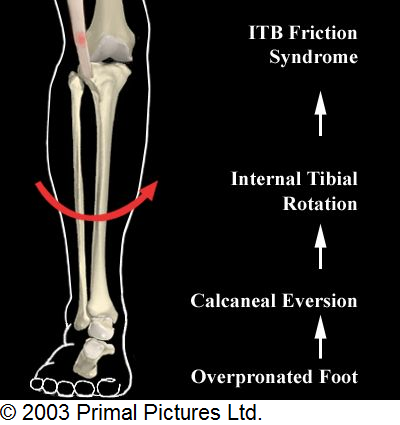Brian Schiff’s Blog
Injury Prevention, Sports Rehab & Performance Training Expert
By far, I help more people with knee and shoulder problems in my profession. As a therapist and fitness pro, I often use lingo that some do not fully understand. In fact, I often find myself analyzing gait patterns of people at the grocery store and even the ringmaster at the circus this past weekend. LOL
I guess I am a biomechanics geek of sorts. It just seems as if faulty mechanics stick out like a sore thumb for me wherever I go. Now, when it comes to bony alignment, you can thank your parents to a large degree for your shape and knee alignment.
Obviously, girls have wider hips so they naturally tend to exhibit greater tendencies to have valgus overload (knees cave in with squatting or landing) than males. However, other factors that contribute to valgus overload are:
- Hip tightness (adductors and IT Band)
- Hip weakness (gluteus medius)
- Foot pronation (flatter or collapsing arch)
- Pain (which leads to compensation)
- Improper muscle firing patterns
So, we know valgus is bad. Does this mean neutral and varus are free from worry. Not so. I have seen many people with neutral alignment fall into valgus due to imbalances, poor muscle memory and faulty motor patterns. Varus knees are often subject to excess stress (compression) along the inside of the knee and gapping along the outside of the knee stressing the lateral collateral ligament. Valgus knees offer increased compression on the lateral knee and gapping along the medial knee stressing the medial collateral ligament.
In the end, you simply want to know your alignment and then assess how gravity and ground reaction forces impact your joints. Squatting and gait provide ample cues. Once you know the imbalances, you can address them with exercises.
I helped do orthopedic screenings last night for a local high school and noticed a few steady trends:
- Nearly all of the soccer players had varus knees
- All of the offensive and defensive linemen had valgus knees
- Cheerleaders had the best single leg squat strength and balance
- About 75% of the athletes I saw had less than exemplary single leg dynamic strength/balance
I included two very different pictures below of high school female soccer players doing a drop landing test from an 18″ box. Obviously the valgus landing is more predictive for ACL and knee injury.

Minimal valgus at landing

Significant valgus at landing
Obviously the girl in the second picture has a higher inherent risk of a serious non-contact knee injury. I recommend a knee prevention program for all cutting and jumping athletes, but when you see this type of valgus loading sound the alarm and be sure to implement a corrective exercise plan to reduce injury risk.
I am putting the finshing touches on my ACL prevention DVD as I write this. You can still take advantage of the pre order sale if you act now. Visit www.fitknees.com for more info.
In all my years as a therapist and strength and conditioning professional, I have seen many active people affected by stress fractures or stress reactions. If you are a runner, you may have experienced such a thing. Likewise, people beginning a new exercise program or rapidly increasing training volume and/or intensity may be at increased risk for such an injury.
Common stress reaction injuries and stress fractures include:
- 5th metatarsal stress fracture
- Shin splints
- Medial tibial stress syndrome (MTSS)
- Tibial and fibular stress fractures
- Femoral neck (hip) stress fracture
- Spinal stress reactions/fractures
Runners, soccer players and gymnasts are often the groups of athletes most likely to suffer these types of injuries. The repetitive impact leads to breakdown in the bone or bone edema (swelling in the bone). What starts out as a mild ache may quickly turn into sharp pain if you fail to heed the warning signs.
Signs and symptoms of stress injuries or stress fractures include: aches or pain with increased loading (running, jumping, and stress at extreme ranges of motion), decreased range of motion, decreased strength and altered gait patterns. Pain may lessen after resting a few days, but often returns as soon as you resume higher impact activity in the case of a stress fracture.
In my practice, I see these injuries much more often in females. This is likely in part due to calcium deficiencies and and perhaps biomechanicaldifferences that increase force on the joints and bones. Women also lack strength in comparison to men and weakness equates ot less force dissipation and higher chances ofinjury. Typical treatment is rest, ice and anti-inflammatory meds. In some cases immobilization and restricted weight bearing is necessary to allow full healing.
Below is a picture of a metatarsal stress fracture:

If you have a persistent nagging ache or pain in the foot, shin, hip or spine, see your doctor to rule out a stress injury with an x-ray. These injuries are easily treated when diagnosed early on. In some cases, neglect may necessitate an operation to remedy the problem. Once you return to training, it is essential to go slow and use the 10% rule each week (not increasing mileage, volume or intensity more than 10% per week) and using a pain dictated progression in regard to exercise.
Today, I am including a picture to better reveal the physical effects of pronation on the knee joint.

Now, in this photo of the right knee it points out ITB friction syndrome (runner’s knee). You can see how force is transmitted up the kinetic chain based on bio mechanical alignment. With increased internal tibial rotation, ITB irritation is a distinct possibility. In addition, it is important to note that this pronation also leads to increased valgus moments (knee caves inward) leading to added stress to the knee. It may also create increase shear force along the lateral patella and compressive force along the lateral knee joint.
This abnormal force transmission is one of the primary reasons runners with overpronation experience ITB and lateral knee pain. Aside from utilizing arch supports, getting proper footwear and gradually increasing mileage, there are some essential strengthening and stretching exercises to include if you have overpronation issues including:
- ITB stretching
- Hamstring and calf stretching
- Quadriceps strengthening
- Gluteus medius strengthening
- Single leg (knee bent) balance and reaching
- Single leg calf raises to increase arch support by strengthening the posterior tibialis
In the next post, I will review Chondromalacia (softening of the cartilage behind the kneecap) and patello-femoral arthritis, a condition that affects many women over the age of 30. I also wanted to let you know I will be releasing a DVD on knee arthritis in the next few weeks. If you read my blog, you will be entitled to a special pre-release offer as well. Stay tuned for more details.
Today, I begin a series on knee arthritis. Whether you simply want to do simple day to day things like get up out of a chair and walk up/down stairs or return to recreational sports without pain, you need tofirst understand how force (your own body weight) affects your knee. Over the next several posts, I will dive into this topic as I prepare to launch a new exercise DVD in my Fit Knees Series aimed at diminishing arthritic pain.

Severe Pronation
This is the last part of my ACL series (for now anyway). Today, I want to share a simple drill for teaching athletes to decelerate properly when moving side to side. So many kids lack the ability to slow momentum correctly at high speeds. Rather than stay low, they often tend to remain upright.
This posture not only reduces power and quickness, but it also increases injury risk. You see, it is darn near impossible to tear your ACL when the knee is flexed near 90 degrees. The knee is more at risk when the flexion angle is closer to 30 degrees (in general) when examining non-contact injuries. Teaching athletes to stay low will improve force generation, change of direction speed and reduce injuries.
So, in today’s video I will show you how to do just that. Keep in mind this drill can be done for quickness (shorter strides), power (longer strides) or just form work (shown here).
If you enjoyed these videos and want more information on my exact training program to prevent ACL injuries, you can pre order my DVD now. It will normally retail for $34.95, but if you pre order now, you can get it for just $19.95. I will throw in free shipping anywhere in the US too.

To order, simply go to www.BrianSchiff.com.



